Obama in Asia – Part I
Obama in Asia – Part I
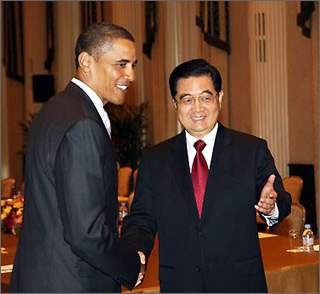
PARIS: The specter of the G2 – a China-US condominium – is haunting European governments as much as the specter of revolution haunted its courts in the days of Karl Marx’s Communist Manifesto. As President Barack Obama mentions a “strategic partnership” on the eve of his departure for Beijing, anxiety is mounting. The words haven’t been used officially since 1996, when then Secretary of State Warren Christopher talked about a “partnership” but rejected the “strategic” adjective promoted by a public Chinese display in Shanghai. What the concern about G-2 shows, though, is insecurity among major countries in the absence of a clear architecture of power.
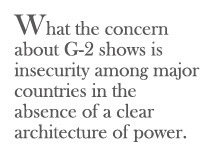
Of course, every official or officious spokesperson in America or China will deny that the G2, a creative acronym coined by Zbigniew Brzezinski, bears any semblance with reality. Indeed, the Obama administration has initially chosen to emphasize “multiple partnerships”, breaking with some of the language of its predecessors. Its most decisive international actions so far have been gestures to reach out towards difficult partners, such as Russia over the issue of anti-missile defense and forward basing of interceptor radars, or partners where there was no established channel of dialogue: Iran, Burma, Sudan. Washington has also reconfirmed the strategic partnership started with India by the 2008 nuclear agreement, a heritage guaranteed to annoy China, and which goes far towards explaining Beijing’s various gestures of irritation at New Delhi. The Chinese could not have failed to notice that there are many holdovers from the Bush era in the area of defense and even at the State Department, and no significant cut in defense spending has been announced.
For their part, Chinese leaders and experts abstain from any emphasis on bilateral Sino-American cooperation. About global economic governance, for example, they either point out America’s responsibility in sparking the 2008 global crisis, or they encourage a more systemic reform of the international economic system. Neither they, nor the US, talk very openly of the role that the world’s two intertwined giants might take together in solving their mutual imbalances, and the implications for third parties. Beijing is still full of hard-line realists in think tanks or the press, who point out strategic disagreements with America. There is also a revival in China of the five principles of pacific coexistence as a guiding principle for foreign policy. This revival serves as a bulwark against what China feels are incessant calls for increased responsibilities and burden sharing. As China’s footprint widens, it is indeed called to take a leading role in resolving problems from North Korea to Iran, from climate change to public governance in Africa. On president Obama’s visit, Afghanistan and Pakistan have been added to this long list.
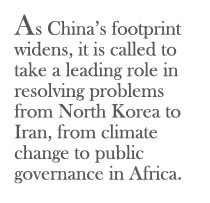
So even if Chinese experts talk of a long-term decline of American influence and strategic leverage, they are the first to point out, defensively, that the US is still in the driver’s seat. Clearly, China prefers to sit back and eventually criticize from a distance. This is consistent with its long-standing strategic conservatism, but also with the view that the burden on the West is increasing with time. Offering good offices between parties, or perhaps whispering some realist advice to a rogue state, seems to be the extent of China’s strategic cooperation. On North Korea, China has simply not changed its basic stance, not even after two nuclear tests. On Taiwan, where America has rooted for a government that is now more in sync with Beijing than ever, there has been no let up in China’s missile deployment across the Taiwan straits. In South Asia and about AfPak – today’s hot war – there is no sign of movement by China beyond communiqués on terrorism. Quite the contrary, China criticizes some aspects of the US military presence, and has pushed on a U.N. enquiry into civilian deaths from aerial strikes in Afghanistan. On Iran, there remains political advocacy and shyness about sanctions, a cocktail not so different from the North Korean case, and with more business interests. On China’s forward deployment of ships to the Somali coast, it hasn’t led to more cooperation or coordination with other nations. Not be forgotten either the incident with the USS Impeccable in March 2009 off the coast of Hainan which served to remind that China disagrees with pervasive US military presence in its neighborhood.
In sum, beyond praise about Barack Obama from high-brow Chinese experts, and a blanket call by the new administration for a “comprehensive relationship”, there is simply no basis for a strategic convergence between the US and China. So why is it that the G2 is such a specter in the room, mentioned at every conference and by many officials outside the United States? Well, for one, appearances matter. At the Pittsburgh G20 summit, President Obama usually addressed President Hu Jintao before anybody else during the leaders’ meeting. And when Secretary of State Hillary Clinton visits Beijing, the Chinese government upgrades the relations with the US as “our most important relationship”. But the talk about G2 is also fuelled by their own angst about their weakness. Europe is on temporary hold because of its eight year long institutional debate. Japan is suffering through a dual crisis – economic recession and political uncertainty. Russia is still resource-rich, but its financial crisis has instilled a new modesty. India hasn’t ridden the crisis as China did. Only Brazil, besides China, is clearly gaining ground in these testing times.
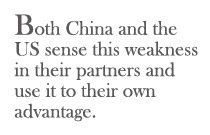
Not only does this create feelings of helplessness about global trends, but both China and the US sense this weakness in their partners and use it to their own advantage. For America, whose exit from the financial crisis depends on trust from the world’s investors, to show undisputed leadership is essential. For China, two factors count. The crisis is a golden opportunity to use its financial resources and its strong government to make decisive gains in all directions. Never has the People’s Republic been so assertive towards its partners. This holds true not only for Europe – viewed with increasing irony for its disunity – but also for Japan or India. Premier Hatoyama’s call for an East Asian Community is met with cool detachment. India, in principle the other rising giant, is mercilessly tested on territorial and other symbolic issues.
But a second factor is also at work – the need for China to hide its acceptance to support the US’ bloated monetary policy. China’s leaders can’t afford a domestic political debate on their relationship with America. They can’t be seen publicly to be doing exactly what they are doing – which is an intense monetary cooperation to save their debtor, and with it their own outstanding claims. It is all the more important for China’s leaders to keep some political distance from Washington.
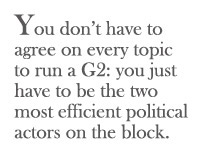
So China’s leaders hedge, as do successive US administrations (it’s called “managing risk” these days). They chitchat with others, talk about multilateralism or a “harmonious world”. And there is expert talk about mutual “mistrust” between China and the US. In truth, there may be less mutual mistrust than political shyness, on each side, to eschew widely different political systems and admit to a G2. You don’t have to agree on every topic to run a G2: you just have to be the two most efficient political actors on the block, with a potential to hurt as well as to help others by your actions.
That’s why everybody else is talking about a G2, and why debates about a G8, G13, 14 or 20 must result soon in a workable new design for global governance. Failing this, China and America’s mixture of interdependence and competition will define our world.